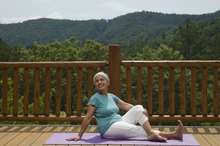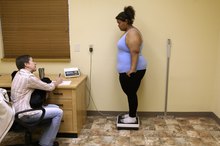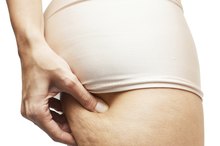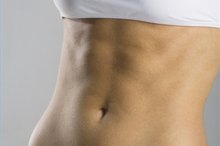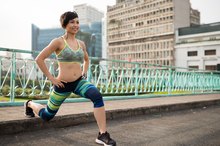What does fact checked mean?
At Healthfully, we strive to deliver objective content that is accurate and up-to-date. Our team periodically reviews articles in order to ensure content quality. The sources cited below consist of evidence from peer-reviewed journals, prominent medical organizations, academic associations, and government data.
The information contained on this site is for informational purposes only, and should not be used as a substitute for the advice of a professional health care provider. Please check with the appropriate physician regarding health questions and concerns. Although we strive to deliver accurate and up-to-date information, no guarantee to that effect is made.
My Thighs Look Terrible With Cellulite & Loose Skin
Loose, sagging skin coupled with dimpled fat on your thighs can make even the most confident person ashamed to expose their legs. Weight loss might seem like the best answer, but cellulite impacts people of all shapes and sizes and you can create more loose skin by dropping even more weight. Permanent, realistic solutions include dietary changes and exercises to target the thigh muscles.
Cellulite Features
Cellulite has an easily identifiable appearance, making your thighs take on the look of a dimpled orange, but it is nothing more than regular body fat. It gets its distinct appearance from body fat pressing upward against connective tissue that holds skin down. According to the American Council on Exercise, women are at greater risk for cellulite because their connective tissue is more tightly structured like a honeycomb, making it easier for thigh fat to bulge and appear dimpled 1. (See Reference 1). Women also tend to carry more excess body fat on their hips, thighs and butt, making the upper leg a common spot for cellulite to develop.
- Cellulite has an easily identifiable appearance, making your thighs take on the look of a dimpled orange, but it is nothing more than regular body fat.
Loose Skin
Why Do I Still Have Cellulite if I Exercise?
Learn More
Losing weight can make you feel better physically and emotionally, but can also leave you with extra sagging skin. This is especially true if you lose a significant amount of weight in a relatively short time. Your skin that once had to cover a large thigh, now covers a much smaller leg. Increasing age leads to decreasing skin health -- firm youthful skin gives way to thinner, weaker skin. MedlinePlus says that as you get older changes to connective tissue can reduce skin's elasticity and strength, especially in areas exposed to the sun like your thighs 2. (See Reference 2).
- Losing weight can make you feel better physically and emotionally, but can also leave you with extra sagging skin.
- MedlinePlus says that as you get older changes to connective tissue can reduce skin's elasticity and strength, especially in areas exposed to the sun like your thighs 2.
Misconceptions
If you were to search for a product to dramatically change the appearance of your thigh skin and cellulite, your options would be endless. The problem is that there is not a cream, wrap or pill that can actually alter the composition of your thigh fat and banish the unsightly cellulite or remove excess skin. The American Council on Exercise says that body wraps only give temporary results and liposuction only removes fat without changing the appearance of it 1.
Prevention and Treatment
Can You Get Rid of Cellulite With Diet & Exercise?
Learn More
Getting your gams back to being gorgeous will take some time and daily effort. Eat a diet that promotes a lean body composition, including plenty of fresh fruits, vegetables, lean protein and whole grains. Avoid fried foods, sweets and high-fat dairy products. Drink at least 64 ounces of water a day to prevent dehydration and reduce the appearance of cellulite. (See Reference 5). Water intake will also improve your skin health for less sagging skin on your thighs. Include thigh toning exercises like squats, lunges and front kicks in your workouts to build lean muscle tissue to combat cellulite and fill out the areas on your thighs with loose skin. (See References 3 and 4). Cardio exercise like running, swimming and cycling burn calories for fat loss while further toning your thighs.
- Getting your gams back to being gorgeous will take some time and daily effort.
- Include thigh toning exercises like squats, lunges and front kicks in your workouts to build lean muscle tissue to combat cellulite and fill out the areas on your thighs with loose skin.
- (
Related Articles
References
- American Council on Exercise: Secrets to Fighting Cellulite
- MedlinePlus: Aging Changes in Skin
- FITDAY: How to Tighten the Skin on Your Thighs after Weight Loss
- FITDAY: 5 Leg Toning Exercises to Tighten Loose Skin after Losing Weight
- ShapeFit: Cellulite Removal
- Dover, J. S., Orringer, J. S., Alam, M. (2014). Body Shaping, Skin Fat and Cellulite E-Book: Procedures in Cosmetic Dermatology Series. United Kingdom: Elsevier Health Sciences.
- Tokarska K, Tokarski S, Woźniacka A, Sysa-Jędrzejowska A, Bogaczewicz J. Cellulite: a cosmetic or systemic issue? Contemporary views on the etiopathogenesis of cellulite. Postepy Dermatol Alergol. 2018;35(5):442-446. doi:10.5114/ada.2018.77235
- Luebberding S, Krueger N, Sadick NS. Cellulite: An evidence-based review. Am J Clin Dermatol. 2015;16(4):243-256. doi:10.1007/s40257-015-0129-5
- American Academy of Dermatology Association. Cellulite treatments: What really works?.
- U.S. Food & Drug Administration. ZELTIQ CoolSculpting System 510(k). Published September 24, 2015.
- Zerini I, Sisti A, Cuomo R, et al. Cellulite treatment: A comprehensive literature review. J Cosmet Dermatol. 2015;14(3):224-40. doi:10.1111/jocd.12154
Writer Bio
Luann Voza teaches both math and science in an elementary school setting and physical education in a college setting. A former fitness-club owner, Voza has taught group fitness classes in step, aerobics, yoga, Pilates and kickboxing. As a bodybuilder, she held the title of Ms. New Jersey Lightweight Division Winner. Voza has a master's degree in exercise physiology and a doctoral degree in education.

